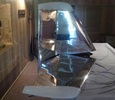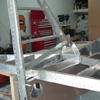


random user submitted photo
cylinder head studs
24 posts
• Page 3 of 3 • 1, 2, 3
Re: cylinder head studs
I just found this old thread and thought it was worth a revisit.
It seems that many of us have varied experiences with the head studs and case savers either leaking, not leaking, drilled through the case into the crankcase or not drilled through. For those that simply screwed your head studs into the engine, (per Aerovee manual instructions), and never experienced any leaks...I am really jealous!
This is simply my experience. I found that of the 16 head stud locations in our VW's, 8 were blind, (meaning that the drilling did NOT go all the way through the cases into the crankcase), and 8 were through drilled and open to the interior of the crankcase.
All 16 holes had case savers pre-installed by Sonex or their vendor.
None of the 8 that are blind, (don't reach the crankcase), can leak. They are not exposed to internal engine oil.
However, the other 8 that are through-drilled can leak in 2 ways.
1. If the case savers were not thread sealed at installation, oil can leak between the case and the case saver. (I don't know if they were sealed or not. They would have been if I had installed them)
2. Oil can leak through the threads between the case savers and the head studs.
It is no secret that we chase oil leaks in VW engines. They are frustrating and in Kerry's words from previous posts and emails one "must find the leak and fix it". This is not a flippant statement by Kerry, it is simply the only way to stop an oil leak and no one can do it but us.
There are only so many normal places that oil can leak from. Sump, oil pump and returns, prop hub, main seal, pushrod tubes, cylinder bases, head studs/case savers, case bolts, cam bolts, dipstick tube, case venting, oil cooler and fittings, oil pressure and temperature senders, head stud bolts and nuts inside the heads under the valve covers, and in the case of the turbo's, the oil lines that run to and from the turbo. Most of these are hard to spot because moving air moves oil everywhere.
Don't forget that the crankcase is pressurized while it runs. It will try to push oil mist and air out through any escape it can find. We have a breather at the top of the engine, but I was pushing oil through the prop hub until I installed an Antisplat oil separator which is plumbed into the exhaust and creates a slight negative pressure in the crankcase. I did not install it for that reason. I just wanted a smaller separator than the Aerovee one because there is such limited space behind the Aerovee with the turbo. But, from the day I installed it, my prop hub went bone dry. It was the only change I made.
If you have a leak somewhere else it is likely a cracked case. Very rare for us. I haven't heard of any instances with Aerovee. Some of you might have.
Finally, the point of this post. Since we KNOW that these things are subject to leaking, why take the chance when building the motor? Seal the through-drilled head studs! Use any of the sealants that are designed for the purpose or that you like. I suggest a sealant that is designed to work while in the temperature range that the Aerovee generates and while in contact with oil and fuel.
It takes nothing to seal these during initial assembly and is a MAJOR pain in the ass to do it after you find oil all over the side and rear of the engine and dripping down the cowl. These leaks are hard to diagnose. They show up on the rear of the engine and appear to be main seal leaks. Moving air blows the oil all over. Very frustrating and makes you doubt everything in your assembly.
My head studs are now sealed. I also think the assembly manual should note this and suggest the option to seal these. It is silent on the matter. For those builders that don't want to seal the head studs, great. Maybe you will be one of the lucky ones. Why take the chance?
It seems that many of us have varied experiences with the head studs and case savers either leaking, not leaking, drilled through the case into the crankcase or not drilled through. For those that simply screwed your head studs into the engine, (per Aerovee manual instructions), and never experienced any leaks...I am really jealous!
This is simply my experience. I found that of the 16 head stud locations in our VW's, 8 were blind, (meaning that the drilling did NOT go all the way through the cases into the crankcase), and 8 were through drilled and open to the interior of the crankcase.
All 16 holes had case savers pre-installed by Sonex or their vendor.
None of the 8 that are blind, (don't reach the crankcase), can leak. They are not exposed to internal engine oil.
However, the other 8 that are through-drilled can leak in 2 ways.
1. If the case savers were not thread sealed at installation, oil can leak between the case and the case saver. (I don't know if they were sealed or not. They would have been if I had installed them)
2. Oil can leak through the threads between the case savers and the head studs.
It is no secret that we chase oil leaks in VW engines. They are frustrating and in Kerry's words from previous posts and emails one "must find the leak and fix it". This is not a flippant statement by Kerry, it is simply the only way to stop an oil leak and no one can do it but us.
There are only so many normal places that oil can leak from. Sump, oil pump and returns, prop hub, main seal, pushrod tubes, cylinder bases, head studs/case savers, case bolts, cam bolts, dipstick tube, case venting, oil cooler and fittings, oil pressure and temperature senders, head stud bolts and nuts inside the heads under the valve covers, and in the case of the turbo's, the oil lines that run to and from the turbo. Most of these are hard to spot because moving air moves oil everywhere.
Don't forget that the crankcase is pressurized while it runs. It will try to push oil mist and air out through any escape it can find. We have a breather at the top of the engine, but I was pushing oil through the prop hub until I installed an Antisplat oil separator which is plumbed into the exhaust and creates a slight negative pressure in the crankcase. I did not install it for that reason. I just wanted a smaller separator than the Aerovee one because there is such limited space behind the Aerovee with the turbo. But, from the day I installed it, my prop hub went bone dry. It was the only change I made.
If you have a leak somewhere else it is likely a cracked case. Very rare for us. I haven't heard of any instances with Aerovee. Some of you might have.
Finally, the point of this post. Since we KNOW that these things are subject to leaking, why take the chance when building the motor? Seal the through-drilled head studs! Use any of the sealants that are designed for the purpose or that you like. I suggest a sealant that is designed to work while in the temperature range that the Aerovee generates and while in contact with oil and fuel.
It takes nothing to seal these during initial assembly and is a MAJOR pain in the ass to do it after you find oil all over the side and rear of the engine and dripping down the cowl. These leaks are hard to diagnose. They show up on the rear of the engine and appear to be main seal leaks. Moving air blows the oil all over. Very frustrating and makes you doubt everything in your assembly.
My head studs are now sealed. I also think the assembly manual should note this and suggest the option to seal these. It is silent on the matter. For those builders that don't want to seal the head studs, great. Maybe you will be one of the lucky ones. Why take the chance?
Last edited by pappas on Sat Sep 18, 2021 6:39 pm, edited 1 time in total.
Lou Pappas
Phoenix, AZ
RV-7A (Building)
Waiex B Turbo
RV-8
Waiex Legacy 3300
Hiperlight SNS-9
Falcon Ultralight[/b]
Phoenix, AZ
RV-7A (Building)
Waiex B Turbo
RV-8
Waiex Legacy 3300
Hiperlight SNS-9
Falcon Ultralight[/b]
- pappas
- Posts: 339
- Joined: Wed Feb 15, 2017 11:27 am
Re: cylinder head studs
Please go back and post this 5 years ago. Thanks!
Bryan Cotton
Poplar Grove, IL C77
Waiex 191 N191YX
Taildragger, Aerovee, acro ailerons
dual sticks with sport trainer controls
Prebuilt spars and machined angle kit
Year 2 flying and approaching 200 hours December 23
Poplar Grove, IL C77
Waiex 191 N191YX
Taildragger, Aerovee, acro ailerons
dual sticks with sport trainer controls
Prebuilt spars and machined angle kit
Year 2 flying and approaching 200 hours December 23
-

Bryan Cotton - Posts: 5090
- Joined: Mon Jul 01, 2013 9:54 pm
- Location: C77
Re: cylinder head studs
An AP friend uses this method to seal studs and inserts. He recognizes that it is not on any documented approved methodology. But it works:
"Clean the oil from the threads and nut with degreaser and air blast, then applying After Torque thread locker. It wicks into spaces and hardens and can seal the oil leak in most cases. The threads must be cleaned if you ever disassemble for a cylinder replacement or retorque."
We both chase leaks by cleaning the engine, dusting overall with talcum powder from a puffer bottle, running the engine and looking to see where the oil is originating from as it tracks across the talc.
"Clean the oil from the threads and nut with degreaser and air blast, then applying After Torque thread locker. It wicks into spaces and hardens and can seal the oil leak in most cases. The threads must be cleaned if you ever disassemble for a cylinder replacement or retorque."
We both chase leaks by cleaning the engine, dusting overall with talcum powder from a puffer bottle, running the engine and looking to see where the oil is originating from as it tracks across the talc.
Graeme JW Smith
-

GraemeSmith - Posts: 939
- Joined: Sat May 18, 2019 8:58 am
- Location: RI
Re: cylinder head studs
Yeah, talcum in a puffer bottle is my friend too! I WISH I had found the thread 5 years ago
Lou Pappas
Phoenix, AZ
RV-7A (Building)
Waiex B Turbo
RV-8
Waiex Legacy 3300
Hiperlight SNS-9
Falcon Ultralight[/b]
Phoenix, AZ
RV-7A (Building)
Waiex B Turbo
RV-8
Waiex Legacy 3300
Hiperlight SNS-9
Falcon Ultralight[/b]
- pappas
- Posts: 339
- Joined: Wed Feb 15, 2017 11:27 am
24 posts
• Page 3 of 3 • 1, 2, 3
Who is online
Users browsing this forum: No registered users and 8 guests







